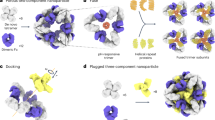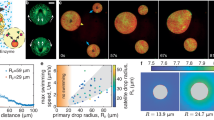Abstract
In polymer–colloid mixtures1,2, non-adsorbing polymers dispersed with much larger colloids provide a universal yet specific entropic attraction between the colloids3,4,5,6,7,8. Such so-called depletion interaction2,3 arises from an osmotic-pressure imbalance caused by the polymers and is considered to be independent of temperature. Here we show that, for the most commonly used polymer–colloid depletion systems5,6, the polymer undergoes a crossover from non-adsorbing to adsorbing9 and that, consequently, the effective colloidal interactions depend on temperature. We also find that a combination of the enthalpic (polymer bridging10,11,12) and entropic (polymer exclusion2,3,4) interactions, both attractive, leads to a re-entrant regime where the colloids are dispersed and form solids both on heating and on cooling. We provide a simple model to explain the observed transitions and to fill the theoretical gap at the polymer-adsorption crossover2,9. Our findings open possibilities for colloidal self-assembly5,13, the formation of colloidal crystals14,15 and glasses16, and the behaviour of temperature-controlled viscoelastic materials.
This is a preview of subscription content, access via your institution
Access options
Subscribe to this journal
Receive 12 print issues and online access
$259.00 per year
only $21.58 per issue
Buy this article
- Purchase on Springer Link
- Instant access to full article PDF
Prices may be subject to local taxes which are calculated during checkout





Similar content being viewed by others
References
De Gennes, P. G. Ultradivided matter. Nature 412, 385–385 (2001).
Russel, W. B., Saville, D. A. & Schowalter, W. R. Colloidal Dispersions (Cambridge Univ. Press, 1989).
Asakura, S. & Oosawa, F. On interaction between 2 bodies immersed in a solution of macromolecules. J. Chem. Phys. 22, 1255–1256 (1954).
Dinsmore, A., Yodh, A. & Pine, D. Entropic control of particle motion using passive surface microstructures. Nature 383, 239–242 (1996).
Sacanna, S., Irvine, W. T. M., Chaikin, P. M. & Pine, D. J. Lock and key colloids. Nature 464, 575–578 (2010).
Kraft, D. J. et al. Surface roughness directed self-assembly of patchy particles into colloidal micelles. Proc. Natl Acad. Sci. USA 109, 10787–10792 (2012).
Perry, R. W., Meng, G., Dimiduk, T. G., Fung, J. & Manoharan, V. N. Real-space studies of the structure and dynamics of self-assembled colloidal clusters. Faraday Discuss. 159, 211–234 (2012).
Rossi, L. et al. Cubic crystals from cubic colloids. Soft Matter 7, 4139–4142 (2011).
De Gennes, P. G. Polymer solutions near an interface. Adsorption and depletion layers. Macromolecules 14, 1637–1644 (1981).
Dickinson, E. & Eriksson, L. Particle flocculation by adsorbing polymers. Adv. Colloid Interface Sci. 34, 1–29 (1991).
De Gennes, P. G. Polymers at an interface. 2. Interaction between two plates carrying adsorbed polymer layers. Macromolecules 15, 492–500 (1982).
Healy, T. W. & Mer, V. K. L. The adsorption–flocculation reactions of a polymer with an aqueous colloidal dispersion. J. Phys. Chem. 66, 1835–1838 (1962).
Sacanna, S. et al. Shaping colloids for self-assembly. Nature Commun. 4, 1688 (2013).
Tan, P., Xu, N. & Xu, L. Visualizing kinetic pathways of homogeneous nucleation in colloidal crystallization. Nature Phys. 10, 73–79 (2014).
Meng, G., Paulose, J., Nelson, D. R. & Manoharan, V. N. Elastic instability of a crystal growing on a curved surface. Science 343, 634–637 (2014).
Fris, J. A. R., Appignanesi, G. A. & Weeks, E. R. Experimental verification of rapid, sporadic particle motions by direct imaging of glassy colloidal systems. Phys. Rev. Lett. 107, 065704 (2011).
Dijkstra, M., Brader, J. M. & Evans, R. Phase behaviour and structure of model colloid–polymer mixtures. J. Phys. Condens. Matter 11, 10079 (1999).
Schade, N. B. et al. Tetrahedral colloidal clusters from random parking of bidisperse spheres. Phys. Rev. Lett. 110, 148303 (2013).
Warren, P. B., Ilett, S. M. & Poon, W. C. K. Effect of polymer nonideality in a colloid–polymer mixture. Phys. Rev. E 52, 5205–5213 (1995).
Branca, C. et al. Study of conformational properties of poly (ethylene oxide) by SANS and PCS techniques. Phys. Scr. 67, 551–554 (2003).
Badaire, S., Cottin-Bizonne, C., Woody, J. W., Yang, A. & Stroock, A. D. Shape selectivity in the assembly of lithographically designed colloidal particles. J. Am. Chem. Soc. 129, 40–41 (2007).
Dontula, P., Macosko, C. & Scriven, L. Model elastic liquids with water soluble polymers. AIChE J. 44, 1247–1255 (1998).
Swenson, J., Smalley, M. V. & Hatharasinghe, H. L. M. Mechanism and strength of polymer bridging flocculation. Phys. Rev. Lett. 81, 5840–5843 (1998).
Feng, L. et al. Cinnamate-based DNA photolithography. Nature Mater. 12, 747–753 (2013).
Wu, K. T. et al. Polygamous particles. Proc. Natl Acad. Sci. USA 109, 18731–18736 (2012).
Crocker, J. C. & Grier, D. G. Methods of digital video microscopy for colloidal studies. J. Colloid. Interface Sci. 179, 298–310 (1996).
Edmond, K. V. et al. Tracking the Brownian diffusion of a colloidal tetrahedral cluster. Chaos 21, 041103 (2011).
Kim, A. J., Biancaniello, P. L. & Crocker, J. C. Engineering DNA-mediated colloidal crystallization. Langmuir 22, 1991–2001 (2006).
Noro, M. G. & Frenkel, D. Extended corresponding-states behavior for particles with variable range attractions. J. Chem. Phys. 113, 2941–2944 (2000).
Lin, K-h., Crocker, J. C., Zeri, A. C. & Yodh, A. G. Colloidal interactions in suspensions of rods. Phys. Rev. Lett. 87, 088301 (2001).
Eckert, T. & Bartsch, E. Re-entrant glass transition in a colloid–polymer mixture with depletion attractions. Phys. Rev. Lett. 89, 125701 (2002).
Chen, Q., Bae, S. C. & Granick, S. Directed self-assembly of a colloidal kagome lattice. Nature 469, 381–384 (2011).
Glotzer, S. C. & Solomon, M. J. Anisotropy of building blocks and their assembly into complex structures. Nature Mater. 6, 557–562 (2007).
Mirkin, C. A., Letsinger, R. L., Mucic, R. C. & Storhoff, J. J. A DNA-based method for rationally assembling nanoparticles into macroscopic materials. Nature 382, 607–609 (1996).
Alivisatos, A. P. et al. Organization of ‘nanocrystal molecules’ using DNA. Nature 382, 609–611 (1996).
Wang, Y. F. et al. Colloids with valence and specific directional bonding. Nature 491, 51–55 (2012).
Acknowledgements
We would like to thank A. Grosberg, D. Grier, A. Hollingsworth, G. Hunter, K. Edmond and D. Kraft for fruitful discussions. This work is supported partially by the NSF MRSEC Program under Grant No. DMR-0820341 for materials, and NASA NNX08AK04G for microscopy. L.F., B.L. and P.C. acknowledge support from DOE-BES-DE-SC0007991 for thermal and optical measurements, data acquisition and analysis.
Author information
Authors and Affiliations
Contributions
L.F. and P.C. initiated the project. L.F., B.L. and S.S. performed the experiments. L.F., B.L. and P.C. developed the theoretical model. All authors analysed the data and wrote the paper.
Corresponding author
Ethics declarations
Competing interests
The authors declare no competing financial interests.
Supplementary information
Supplementary Information
Supplementary Information (PDF 1389 kb)
Supplementary Information
Supplementary Movie S1 (MP4 10371 kb)
Supplementary Information
Supplementary Movie S2 (MP4 10428 kb)
Rights and permissions
About this article
Cite this article
Feng, L., Laderman, B., Sacanna, S. et al. Re-entrant solidification in polymer–colloid mixtures as a consequence of competing entropic and enthalpic attractions. Nature Mater 14, 61–65 (2015). https://doi.org/10.1038/nmat4109
Received:
Accepted:
Published:
Issue Date:
DOI: https://doi.org/10.1038/nmat4109
This article is cited by
-
Polymorphic crystalline wetting layers on crystal surfaces
Nature Physics (2023)
-
Tunable assembly of hybrid colloids induced by regioselective depletion
Nature Materials (2020)
-
On the mechanism behind the inverse melting in systems with competing interactions
Scientific Reports (2019)
-
Curvature instability of chiral colloidal membranes on crystallization
Nature Communications (2017)
-
Processable high internal phase Pickering emulsions using depletion attraction
Nature Communications (2017)



